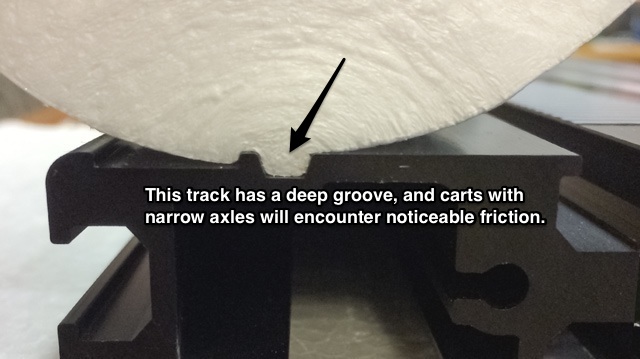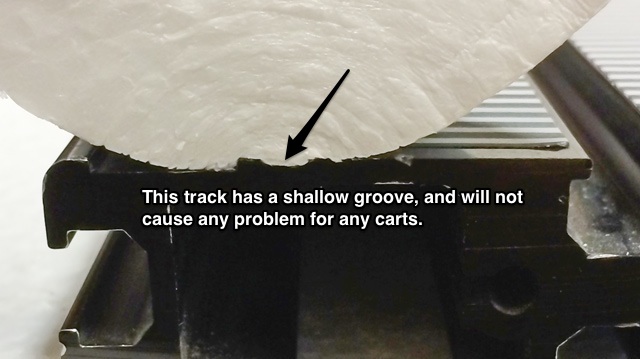The spacing of the wheels on carts made between November 18, 2013, and April 18, 2014, was effectively 0.6 mm narrower than previously. All cart models (Standard Cart, Plunger Cart, and Motion Encoder Cart) are affected. On most tracks, the narrower wheel spacing has no effect on use, since there is sufficient tolerance to the design that no new friction is introduced.
However, on certain tracks with deep grooves, the combination of the narrow wheel spacing width and the deeper grooves creates more friction than is acceptable for a system designed to have very low friction. The wheels still spin freely when the cart is not on a track.
We will replace the wheels on the affected carts. Information on that procedure is at the end of this note.
The following steps are necessary to determine if you have the cart and track combination that causes problems. If you purchased an entire track-and-carts system between November 18 and April 18, it is likely that your carts are affected.
First, look at the end of the black track. You’ll see that there are two grooves in which the cart wheels will ride. One groove is narrow. The other is wider. If the wide groove is visibly shallower than the narrow groove, then your track will work with all carts. If all of your tracks have the shallow wide groove, you will not experience this problem, and you can stop reading.


On the other hand, if some or all of your tracks have a wide groove that is visibly deeper than the narrow one, the carts you received during the time period of November 18 2013 to April 18 2014 may not work well with those tracks. Not all carts have the narrow wheel spacing that is incompatible with the deep groove tracks.
You will need to test the wheels on your carts purchased during the four-month time period using a deep-grooved track. Older or newer carts should be fine. Level the track so that a cart at rest does not start rolling in either direction. Confirm that the cart wheels are in the grooves. Now give the cart a small nudge to start it rolling. If it rolls freely, your cart is fine. If it quickly comes to rest, your cart needs new wheels.
Determine the number of carts showing the problem, and let us know. At your discretion, Vernier will either send replacement wheels or set up a repair so that we will replace the wheels. While we are happy to do the work for you, wheel replacement is very simple. You may prefer to do the work yourself rather than shipping the carts back to us.
Information on replacing wheels can be found at How do I replace the wheels on green, aluminum (VDS) dynamics carts?
